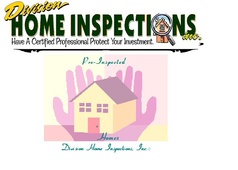Your Home Inspection is Completed, What Next?
by:
Fred Duemig
Owner & Senior Inspector
Division Home Inspections, Inc.
Informed Consumer
Consumers of today are much more informed than consumers of the past. I am sure the internet plays a huge roll, putting information, service providers, competition, tips and details at our fingertips. Accordingly, most informed perspective home buyers are choosing to have a professional home inspection performed on the property they consider purchasing.
We Had The Inspection - What Next?
After receiving the inspection report, first, and most importantly, read it and read it again. The report is loaded with valuable information and should be read thoroughly to comprehend all details. With paper and pencil in hand, make a list of all the items in the report that are of concern to you. They can be prioritized, for example:
•· Major Concern (Roof Needs Replacement)
•· Safety Concern (Electrical Fire Hazard)
•· Minor Concern (Cosmetic Defect)
•· Nuisance Item (Location of Laundry, Lack of Dishwasher)
•· Etc.
Try to set a monetary amount for each concern. In some cases, such as a badly needed roof, get estimates, preferably three. However, due to the schedule of real estate transactions, and others possibly bidding on the same property, obtaining estimates quickly enough may not be realistic.
So, What Do I Do?
Do your research! Remember the internet? You may have researched the internet to get this far, so don't stop now. Do searches related to your concerns. Ask your friends, neighbors and relatives who have had similar tasks done and how much they paid. Use a cost guide, (I include one with every report*), to estimate the cost. Make a detailed list along with related costs. Use the list to negotiate price with the seller. The original purchase price was negotiated with some "unknowns" about the property. But several issues have surfaced thanks to a thorough inspection. Most likely, the seller didn't realize some of these issues either. Use your realtor and/or lawyer to help with the negotiation. Some problems, such as a leaking roof or termite infestation will be easier to settle. However, others, such as cosmetic issues may be more difficult. You may bargain to have the seller repair the agreed upon items or discuss a price reduction based on your list of concerns.
Now What?
You have two options here.
- Contact your inspector, and ask him if he does pre-closing walkthrough inspections. In most cases, the inspector will charge about $150 to assist you with your pre-closing walk through. You provide the inspector with the list of items the seller agreed to repair or replace. The inspector accompanies you on the walkthrough and verifies that the items were indeed done and the quality of the repair or replacement. He also will make a cursory check to see if any major changes have occurred or if new conditions exist since the inspection.
- Format a pre-closing walkthrough checklist for yourself. Make sure you add all the agreed upon items. Things to check for (Not all-inclusive):
- Determine if repairs required by your contract have been completed.
- Determine if basic systems are in working order.
- Obtain all operational manuals, well/septic records, records of sale (disclosure statement, offer to purchase, and closing documents), warranties and receipts for recent repairs. Keep them in a file.
- Check the exterior. Pay particular attention to the roof, especially if there has been a storm since the inspection. Run the sprinklers and/or ask for a demonstration if weather permits.
- Check all interior rooms. Check for moving damage if the homeowner moved out between the inspection and closing. Operate all windows and doors and check for broken thermal pane seals, loose hardware, etc. Check ceilings for water stains.
- Check all areas that may have been inaccessible during the inspection due to personal storage, furniture, area rugs, etc. and check items we don't review such as cosmetic concerns, alarms, intercoms and sound systems.
- Operate all systems/appliances, sump pump and the garage door. Obtain door transmitters. Do not operate air conditioners if the temperature is below 65 degrees. Check lights (bring a couple bulbs).
- Run all faucets and toilets. Fill tubs and sinks. Check for leaks. Run whirlpool tubs
- Check basement and/or crawl space. Look for active stains and leaks at walls, floors and under and near plumbing.
- If possible, check inside of the attic.
- Verify that the seller has correctly completed any promised repairs (look at receipts, permits, etc)
Lastly?
Good luck and enjoy your new home. Keep up on home, system and grounds maintenance. Keep all receipts, warranties and important papers in a safe place. Refer to a homeowners guide, (I include one with every inspection).
For more information visit http://www.divisioninspect.com
*Remember, the cost guide is just that, a guide and should be used only to estimate costs. Actual estimates will vary.

Comments(0)